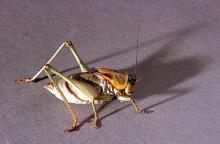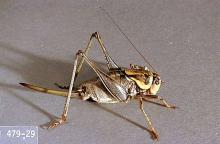Anabrus simplex
Pest description and crop damage Flightless, heavy katydids that feed on many range plants as well as on small grains and alfalfa. They migrate from pastures into crop fields during outbreak years.
Management-biological control
- Nosema locustae (NOLO Bait Biological Insecticide)-Apply early in the season, as the over-wintering grasshoppers emerge. Two to three weeks may be required for initial effect. Broadcast 1 to 2 lb/A around the entire infested area, as well as outlying areas such as drying grasses and fields. Heavy infestations may require repeated applications.
Management-chemical control
- carbaryl (Carbaryl 4L) at 0.5 quarts ai/A. PHI 0 days. Reduced Agent and Area Treatment (RAAT) is required. Do not exceed 1 quart ai/A per year. REI 12 hr. Do not apply during bloom. May be harvested or grazed same day as treatment.
- carbaryl (Carbaryl 5% Bait, Sevin 5 Bait)-Apply 20 lb per acre by ground application only. Aerial application 4 lb/A with 2 applications allowed per year with 14-day treatment interval. Use restrictions: do not apply more than once per year.
- diflubenzuron (Dimilin 2L, Durant 2L)-Do not apply more than 6 fl oz of product (1.5 oz/ai diflubenzuron) per acre per calendar year. Apply at 1 to 2 fl oz/A; use 1 application on early instar (majority in the 2nd through 4th instar nymphal stages); use high rate for pastureland. Or, apply on rangelands (only) in a RAATs application on early instars at rate of 0.75 to 1.0 fl oz/A. If applying a second application, apply two to three weeks after the first application at a rate between 0.5 to 1.0 fl oz/A.



